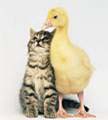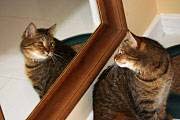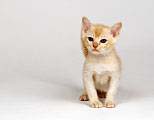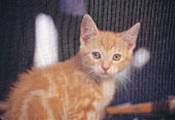Part-V: Caring for Your Cat
Twenty Tips for Caring for Your Cat
Cats are excellent pets. Follow these simple tips to care for a
great life-long companion.
Local governments have their own cat registration laws.
Adhere to these laws to ensure complete protection.
Get a cat collar with a tag where you put all necessary details
like the name of your pet, your name, and contact details.
This assures the safe return of your pet if you lose your pet for any reason.
Feed your cat a nutritional and well-balanced diet and ensure
easy access to fresh, clean water to keep your cat healthy and
fit.
Take your cat to the veterinarian for regular checkups. It is
necessary to schedule vet visits from the time you bring home
your kitten.
Keep your furniture safe from scratching episodes. You can
train cats to use special scratching posts. Cats are fast
learners.
Copyright © 2007paul Brough ~ All Rights Reserved
Page 66 of 102
“Understanding, Caring for and Training Your Cat” by Paul Brough Page 67 of
102
Have the Vet neuter or spay your cat at the age they advise.
This helps maintain the health of your cat.
Regular grooming of your cat’s coat will keep it soft, shiny and healthy. It prevents ingestion of hair by cats – that may cause
serious problems due to hairballs.
Always set aside separate and exclusive time for playing and
spending time with your cat. Plan regular exercise sessions to
maintain the physical health of your cat. It also helps you
bond with your feline companion. This is essential to ensure a
stable and happy mental state of your pet cat.
Start training your kitten from the time you bring it home.
Kittens are small bundles of high-energy. Be gentle but be
firm too. Place a ticking clock in its bed to mimic its mother’s heartbeat. Offer small and safe toys for your kitten to play and enjoy.
Litter training is essential. Place your kitten’s litter box in a well-ventilated and private place. Keep separate litter boxes
for each kitten.
Do not allow your cat to venture outdoors without supervision.
Restrict such outings, as it might have an accident or contract
an illness. Keep your cat indoors to maintain the health of
your cat.
You should never inflict any physical punishment on your
kittens or cats. It only confuses them and makes them scared
of you.
Copyright © 2007paul Brough ~ All Rights Reserved
Page 67 of 102
“Understanding, Caring for and Training Your Cat” by Paul Brough Page 68 of
102
Protect your cat from inquisitive and rough handling of your
guests. Keep them in a separate room to avoid any
unpleasantness. Cats could inflict harm, as they could scratch
to protect themselves.
Caring for a pregnant cat requires extra care and attention. Do
not allow it outdoors. Give it additional food according to your vet’s instructions. Give it a nice and cozy bed. Collect
complete information in advance about cat care for such
special times.
Cats are very possessive and may not like extra attention you
shower on your newborn baby. Instead, reassure your cat by
giving it a little more attention.
Your pet cats could wake you at unseemly hours to have their
food. Discourage such habits and do not give them anything at
such times. Cats learn to respect feeding times and will soon
fall into a regular routine.
Get pet-sitters to care for your cat while you go on vacation.
Allow sufficient time for your cat to grasp and learn the correct behavior you expect of it.
Medical care for your cat could be costly. Get information from
the Internet to reduce vet visits but always get the advice of
your local vet on serious matters.
Get your cat accustomed to all kinds of dry and wet food so
that you can feed it any type of food.
Copyright © 2007paul Brough ~ All Rights Reserved
Page 68 of 102




“Understanding, Caring for and Training Your Cat” by Paul Brough Page 69 of
102
14. Grooming Your Cat and Hygiene
Though your cat spends lot of time cleaning itself, they do
need a regular brushing and cleaning. This helps to remove
the loose hair, dead skin and also prevents matting. Regular
brushing helps to keep parasites and fleas away.
Regular grooming
Regular grooming should be started early in the life of a cat
and done regularly. If you have a long-haired cat, you will
need more frequent sessions. However, with short-haired cats,
once a week is sufficient to prevent matting.
Regular grooming helps to keep your cat not only good and
healthy, but also helps you to develop a wonderful bond with
your pet. You get to know your cat well through these
sessions and you can check for fleas, lumps, sores, ticks or
irritated skin.
Copyright © 2007paul Brough ~ All Rights Reserved
Page 69 of 102
“Understanding, Caring for and Training Your Cat” by Paul Brough Page 70 of
102
Combing
Combing regularly maintains good hygiene among cats. Gently
comb towards the hair growth point and keep tangles away.
You may use your fingers to untangle the fur.
There are combs available in the market for combing your
pet’s hair. Use a comb with wide teeth for cats that have long
hair and a fine-toothed comb for cats with short hair - these
combs are best for picking up fleas and dirt from the cat’s
coat.
Brushing
Brushing regularly stimulates the cat’s skin and helps natural
oils to distribute more evenly. This helps your cat’s fur to
maintain its shininess. You may use a soft bristle brush or a
wire slicker brush. A rubber-grooming device could help to
massage the skin of the cat.
Nail trimming
Use the cat nail trimmer to cut the nails of your cat. Gently
press the paw to bring out the cat’s nail and trim the sharp
point. However, be careful that you do not harm the blood
vessels. You may ask your vet for help when you try it out the
first time.
Bathing
Bathing may not be a favorite practice for every cat. However,
bathing helps prevent tangling and matting. Use medicated
Copyright © 2007paul Brough ~ All Rights Reserved
Page 70 of 102
“Understanding, Caring for and Training Your Cat” by Paul Brough Page 71 of
102
shampoos for your cat. Specific areas that may need particular
attention are:
Ears: Use cotton swabs to clean the cat’s ear, as they trap lot of dirt. Be very careful when you clean the ears.
Eyes and nose: Be particularly careful in wiping their nose and eyes. Wet a cotton ball with saline water to wipe the
eyelids (NOT the eyes) of the cat gently.
Dry the cat: Dry the cat by gently squeezing the excess
water from the fur. After this wrap the cat in a large soft
towel, and then comb any tangles gently.
However, not using a blow dryer is a good idea as the sound
scares most cats.
Copyright © 2007paul Brough ~ All Rights Reserved
Page 71 of 102



“Understanding, Caring for and Training Your Cat” by Paul Brough Page 72 of
102
Cat Diet
Canned cat food is the best for your cat. It
contains all essential nutrients and minerals in
appropriate quantities. It also contains sufficient
water. Canned cat food is available in three
different types:
Crunchy nuggets are available as
dry food or kibble. You can store
these packages at room
temperature for many weeks. They
are economical and you can leave it
in your cat’s feeding bowl all-day without it getting spoiled.
Such crunchy food prevents formation of dental plaque.
However, it could cause bladder stones if eaten to excess.
Wet canned food can stay okay for a
long period if you do not open it. Once
you open it, you can store left overs in
the refrigerator for no more than a
day. It should be put inside an airtight
container. Any leftover or uneaten canned food on cat’s food
bowl should be discarded after fifteen to twenty minutes. It
could accumulate harmful bacteria. You can add a little cooked
pasta, rice or potatoes to regular canned food to add to the
taste and nutrition value.
Copyright © 2007paul Brough ~ All Rights Reserved
Page 72 of 102
“Understanding, Caring for and Training Your Cat” by Paul Brough Page 73 of
102
Semi moist canned food is essentially wet nuggets. It is
available in individual meal-size pouches. Some of them are in
different colors and shapes. You can store them in resealable
containers at room temperature. Such food is not very high in
nutrition.
Additional Foods for Your Cat
A few extra special foods here and there can add flavor to
your cat’s diet. You can give a few bits of tuna fish once-in-a-
while if your cat does not have any urinary tract problems.
Strained meat, minced chicken or turkey, poultry baby foods
and white rice are good for a recuperating cat. Always check
for any bones as bones could lodge within the cat’s throat and
choke it.
Special treats include canned mackerel, herring, or sardines,
chicken giblets, cheese, and vegetables in small quantities.
Fresh water is essential for your cat. Keep a bowl of fresh,
clean water always readily available. Change water every
morning.
Essential Tips
Never feed dog food to your cat, as dog food lacks taurine and
necessary proteins.
Do not feed leftovers from your plate, as it could upset your
cat’s digestive system.
Copyright © 2007paul Brough ~ All Rights Reserved
Page 73 of 102
“Understanding, Caring for and Training Your Cat” by Paul Brough Page 74 of
102
Do not give chocolates, spicy and oily food, or onions to your
cat.
Do not give raw egg whites, uncooked fish, beef, pork,
poultry, or meats not approved by your vet.
Kittens require many small feeds during the day. Keep dry
food available all through the day. Adult cats could do with a
single meal each day.
Maintain a specific feeding schedule for your cat.
Always give food to your cat in a clean bowl. Feed it in the
same bowl and at the same time and place.
Do not allow children to come near your cats while feeding, or
to try to disturb or distract them in any manner.
Copyright © 2007paul Brough ~ All Rights Reserved
Page 74 of 102



“Understanding, Caring for and Training Your Cat” by Paul Brough Page 75 of
102
Playing and Exercise
Cats and kittens love to play with you and other cats or
kittens. Cats normally do not play for long periods. Brief spells of play normally early in the morning and evening can keep
the emotional base of your feline companion intact. It also
maintains the physical health of your cat.
Always maintain a regular playing and exercising time. Stick to
this schedule, as cats would expect you to play at the same
time every day.
Boredom is often the main cause behind aggressive behavior,
overeating, or compulsive chewing habits of your cat.
Interactive playing builds and strengthens bonding between
you and your cat. Shy cats gain a lot of confidence through
such play sessions. They provide physical and mental exercise.
The cat does not feel as much boredom when staying indoors.
Simple Toys That Provide Exercise for Your Cat
Tie a string around a cat toy and hang it in a dangling
position. You can tie any object at the end of a chopstick.
Kittens and cats love jumping and trying to catch the dangling
object.
Copyright © 2007paul Brough ~ All Rights Reserved
Page 75 of 102
“Understanding, Caring for and Training Your Cat” by Paul Brough Page 76 of
102
Cats love playing with paper bags. They would try to explore
within the bag and walk out majestically. You can cut a few
holes in the bag to provide them many exit points. Placing
their toys within these openings would be more enjoyable.
Give an empty toilet paper roll and your cat will play with it
like a bat. You could additionally put some object within the
roll and enjoy watching it play enthusiastically.
Try hiding one of your cat’s toys underneath a pillow or in
between cushions. Your cat would love to play retrieving
games.
Use a flashlight to beam light on the floor and walls in a semi-
dark room. Cats love chasing the beam and it provides both
enjoyment and exercise.
Roll a few ice cubes on a solid floor and your kitten will love
playing ice hockey with them. Alternatively, put a few cubes in
an empty bathtub and enjoy your kitten’s game. Similarly,
ping-pong balls in the bathtub also provide a lot of
entertainment and exercise to your feline companions.
Fresh catnip toys prove very enjoyable to cats. They are
happy tearing away at the toy and releasing more and more
catnip. They then roll in it ecstatically.
Certain motorized toys like mice or toys with fur tails could
incite the predator instinct in your felines. However, do not
overdo this game as it could tire your cat too much.
Copyright © 2007paul Brough ~ All Rights Reserved
Page 76 of 102
“Understanding, Caring for and Training Your Cat” by Paul Brough Page 77 of
102
Provide a windowsill for your cat to have a look outside.
Alternatively, allow it to gaze at an aquarium. Some cats love
watching television. You can put on videotapes of mice or
birds for your cat to sit and watch.
Copyright © 2007paul Brough ~ All Rights Reserved
Page 77 of 102



“Understanding, Caring for and Training Your Cat” by Paul Brough Page 78 of
102
Housing Your Cat
When you bring home your kitten from a shelter or breeder,
it will be away from its mother for the first time. It will be
among new and strange smells, people, and a whole strange
environment.
Allow it time to settle down. Some suggest applying butter to
their paws. This makes cats leave their scent behind and
offers faster acclimatization due to same smells everywhere.
For the initial few days, give it a well-wrapped hot-water
bottle for warmth. Do not change the feed drastically.
Continue with the same diet as it had at its previous home.
Some kittens are allergic to cow’s milk. If it shows signs of
discomfort, discontinue it and reintroduce it later after
sufficient dilution. Dietary changes should be made gradually.
Make a comfortable and snug sleeping box for your kitten
from boxes or baskets. Make sure that there is no way that
the kitten might catch its claws in the weave of a basket or
blanket.
Older cats will prefer sleeping above ground-level, preferably
on a chair or similar elevated places.
Copyright © 2007paul Brough ~ All Rights Reserved
Page 78 of 102
“Understanding, Caring for and Training Your Cat” by Paul Brough Page 79 of
102
Provide sufficient toys and play things for your cat or kitten.
Simple toys include ping-pong balls, toys tied to the end of
strings and hung on doorknobs, large paper bags with many
windows and tunnels.
Blank newsprint could be good bedding for your new cat. Do
not us old newspapers as the ink may contain chemicals that
could be rubbed into the cat’s fur and ingested when the cat
licks itself with possibly harmful results.
But the blank paper is cheap when you can get the ends of
rolls from your local newspaper office, it provides a lot of
warmth and it is easily disposable.
There will not be any problems of lice, worms, or fleas.
Cats prefer staying in warm places.
Use cat baskets with a waterproof base and keep them slightly
elevated. This prevents kittens from remaining in their mess,
if there are any accidents. A litter box is essential for a cat at home.
Change litter daily. Once a week, empty litter completely and
wash the tray thoroughly with detergent and hot water. Do
not use any disinfectants in the litter box cleaning, as cats are allergic to disinfectants. Place the cleaned, dry litter box at a private and secluded place away from noise and disturbances.
Use flat-bottomed feeding and drinking water bowls for your
cat. These bowls should have a solid bottom. Placing feeding
bowls on newspaper sheets can lessen any nuisances of
Copyright © 2007paul Brough ~ All Rights Reserved
Page 79 of 102
“Understanding, Caring for and Training Your Cat” by Paul Brough Page 80 of
102
droppings. Clean these bowls daily with water and remove any
traces of food as soon as possible.
Copyright © 2007paul Brough ~ All Rights Reserved
Page 80 of 102



“Understanding, Caring for and Training Your Cat” by Paul Brough Page 81 of
102























